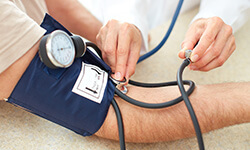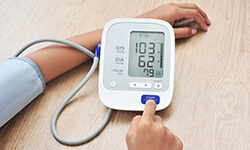While monitoring blood pressure, one usually notices the rise or fall in systolic blood pressure with the assumption that diastolic blood pressure remains within range. Although the risks associated with high systolic blood pressure seem acute, neglecting diastolic blood pressure isn’t the solution. High blood pressure, whether it’s systolic or diastolic, needs equal attention to help curb the problem at the onset.
What Is Diastolic Blood Pressure?
 Diastolic blood pressure is the lower number in a blood pressure reading and is the measurement of your heart, in the relaxed state, between beats. It is a possibility for some to have low diastolic blood pressure while the systolic pressure remains normal. This condition of low diastolic and normal systolic blood pressure is called isolated diastolic hypotension. On the other hand, some people have high diastolic blood pressure and normal systolic blood pressure, and this condition is isolated diastolic hypertension. Either way, any fluctuations in the diastolic blood pressure reading are just as risky for your heart as those in systolic blood pressure.
Diastolic blood pressure is the lower number in a blood pressure reading and is the measurement of your heart, in the relaxed state, between beats. It is a possibility for some to have low diastolic blood pressure while the systolic pressure remains normal. This condition of low diastolic and normal systolic blood pressure is called isolated diastolic hypotension. On the other hand, some people have high diastolic blood pressure and normal systolic blood pressure, and this condition is isolated diastolic hypertension. Either way, any fluctuations in the diastolic blood pressure reading are just as risky for your heart as those in systolic blood pressure.
What Does An Elevated Diastolic Blood Pressure Reading Indicate?
 Minimal elevations in diastolic blood pressure (5-10 mmHg or less than 95 mmHg) alone do not pose an immediate health risk. However, that depends on whether you are in good health and do not have any additional health issues that put you at risk of developing cardiovascular problems. These health problems include kidney disease, diabetes, obesity, thickening of the arteries, or even a history of heart disease.
Minimal elevations in diastolic blood pressure (5-10 mmHg or less than 95 mmHg) alone do not pose an immediate health risk. However, that depends on whether you are in good health and do not have any additional health issues that put you at risk of developing cardiovascular problems. These health problems include kidney disease, diabetes, obesity, thickening of the arteries, or even a history of heart disease.
If you aren’t affected by any of these additional risk factors, regular monitoring of blood pressure and leading a healthy lifestyle is all you need to do to keep your blood pressure at normal. Avoid elevated levels of diastolic blood pressure as it may give rise to high systolic blood pressure, putting you at higher-than-average risk.
In case you are suffering from isolated diastolic hypotension, the muscles of your heart receive less oxygenated blood when your heart relaxes. It weakens your heart and could lead to heart failure. And if your arteries have narrowed, it could lead to coronary heart disease as well. So, how do you identify the symptoms of low diastolic blood pressure?
The symptoms include:
Note: If you notice any of these symptoms, contact your cardiologist or physician immediately.
Whether it’s low or elevated diastolic blood pressure or high systolic blood pressure, effective management of blood pressure is crucial. If left untreated, it can have serious, long-term consequences and life-threatening health issues. Therefore, follow these next steps to ensure your blood pressure remains normal.
 Keep your salt intake to between 1.5-4 grams per day. Ideally, one should take only about 3.5 grams of salt in their food. You can do this by including low-sodium foods in your diet and avoiding added salt in your cooking.
Keep your salt intake to between 1.5-4 grams per day. Ideally, one should take only about 3.5 grams of salt in their food. You can do this by including low-sodium foods in your diet and avoiding added salt in your cooking. Eat a heart-healthy diet with a variety of fruits and vegetables, and include whole grains. For protein, stick to lean meats and fish and avoid fatty and saturated foods.
Eat a heart-healthy diet with a variety of fruits and vegetables, and include whole grains. For protein, stick to lean meats and fish and avoid fatty and saturated foods. Drink enough fluids and avoid alcohol as it increases your risk for dehydration and can elevate blood pressure levels.
Drink enough fluids and avoid alcohol as it increases your risk for dehydration and can elevate blood pressure levels. Stay physically active and begin with an exercise program. However, before you alter your daily regimen, check with your doctor regarding the safest exercises for you, and the duration of each activity to avoid any mishaps.
Stay physically active and begin with an exercise program. However, before you alter your daily regimen, check with your doctor regarding the safest exercises for you, and the duration of each activity to avoid any mishaps. Maintain a healthy weight and avoid fluctuations in weight. If you’re overweight, ask your cardiologist or physician to help you with a safe weight loss plan.
Maintain a healthy weight and avoid fluctuations in weight. If you’re overweight, ask your cardiologist or physician to help you with a safe weight loss plan. Whether you smoke regularly or occasionally, quit smoking altogether. Other than elevating your blood pressure, smoking harms your overall health.
Whether you smoke regularly or occasionally, quit smoking altogether. Other than elevating your blood pressure, smoking harms your overall health.
You must detect and treat any heart or blood pressure related issues at an early stage to get effective treatment. Diastolic blood pressure is just as significant as systolic blood pressure in maintaining your heart health. Therefore, to address the situation effectively, make an appointment with your doctor. They will assess and monitor your blood pressure and the health of your heart and will help you develop a proper plan based on your medical history and other health issues.
Note of Caution: This article is for information purpose only. Always consult your doctor in case of any blood pressure or other health related problems.
Disclaimer
The information contained in this article is to educate, spread awareness in relation to hypertension and other diseases to the public at large. The contents of this article are created and developed by BPinControl.in through its authors, which has necessary, authorisations, license, approvals, permits etc to allow usage of this articles on The Website. The views and opinions expressed in this article are views, opinions of the respective authors and are independently endorsed by doctors. Although great care has been taken in compiling and checking the information in this article, The Website shall not be responsible, or in any way liable for any errors, omissions or inaccuracies in this article whether arising from negligence or otherwise, or for any consequences arising therefrom. The content of this article is not a substitute for any medical advice. The Website shall not be held responsible or liable for any consequence arising out of reliance on the information provided in the article.

 Tiredness
Tiredness Dizziness
Dizziness Chest Pain
Chest Pain Breathing Difficulty
Breathing Difficulty Blurred Vision
Blurred Vision Nausea
Nausea


